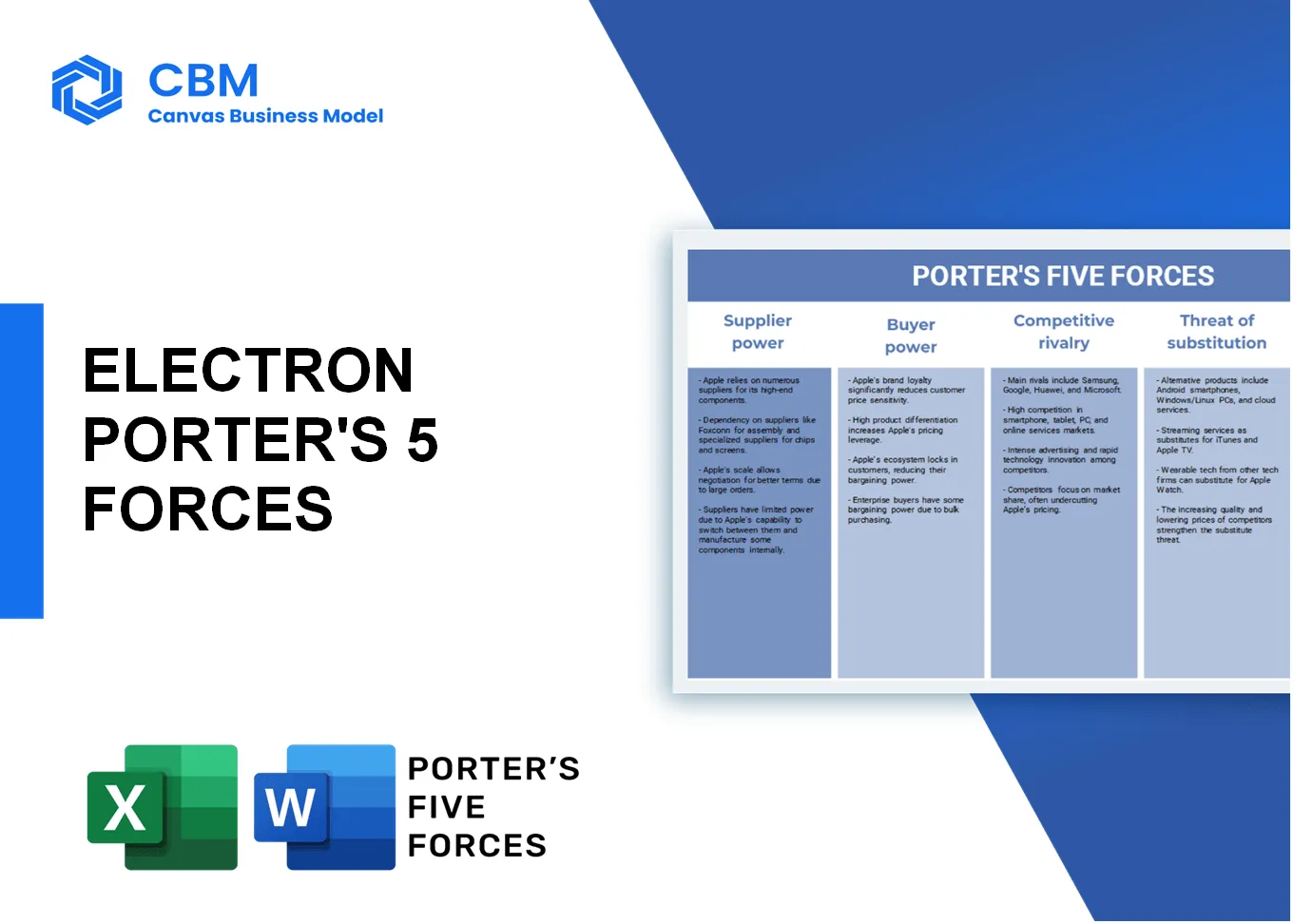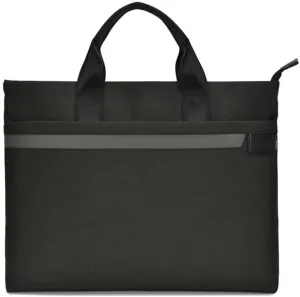In the rapidly evolving landscape of the energy sector, understanding the dynamics of industry power is crucial for companies like Electron. By leveraging Michael Porter’s Five Forces Framework, we can uncover the critical factors influencing bargaining power among suppliers and customers, assess the intensity of competitive rivalry, evaluate the threat of substitutes, and examine the threat of new entrants. Dive deeper below to explore how these forces shape the future of energy transition towards a sustainable Net Zero.
Porter's Five Forces: Bargaining power of suppliers
Limited number of suppliers for specialized energy technologies
The energy sector often relies on a small group of specialized suppliers for advanced technologies. For instance, as of 2023, the number of dominant suppliers for next-generation batteries stands at approximately 12 major companies, including Panasonic, LG Chem, and CATL, which collectively hold over 70% of the market share. This concentration enhances their power to influence pricing.
High switching costs for certain proprietary components
Switching costs for proprietary components can be significant. For instance, bespoke software solutions in energy management systems can cost between $50,000 and $250,000 to develop. Furthermore, companies often spend on long-term contracts for specific technologies, with commitments averaging $500,000 annually, creating substantial hurdles to change suppliers.
Suppliers with advanced capabilities can demand higher prices
Suppliers offering advanced technologies such as AI-enhanced energy analytics can command premium pricing. For example, advanced predictive maintenance solutions can cost around $15,000 per unit compared to traditional solutions priced at $5,000. This disparity allows highly capable suppliers to exert greater influence over pricing strategies.
Potential for vertical integration by suppliers
Vertical integration in the energy supply chain enhances supplier power. Companies like Siemens and GE have expanded their operations by acquiring smaller tech firms to consolidate control over their supply chains. Reports indicate that in 2022, GE acquired three companies specializing in grid technology for a total of $1.2 billion, resulting in an increase in their pricing power due to reduced competition.
Global supplier networks may enhance bargaining leverage
Global supply networks increase the bargaining leverage of suppliers. For example, the global market for renewable energy components is projected to grow by 10.4% annually, reaching an estimated $1.5 trillion by 2028. Suppliers with international operations can leverage their scale to impose stricter terms and conditions on energy companies, significantly affecting overall pricing dynamics.
| Supplier Attribute | Impact on Bargaining Power | Data/Statistics |
|---|---|---|
| Number of Suppliers | Limited | 12 major suppliers control over 70% market share |
| Switching Costs | High | Average switching cost estimated between $500,000 - $250,000 |
| Pricing Variability | High capability leads to higher prices | $15,000 per unit vs $5,000 for traditional solutions |
| Vertical Integration | Consolidates market power | GE acquired 3 firms for $1.2 billion |
| Global Market Growth | Increased leverage | Projected at $1.5 trillion by 2028, growing at 10.4% annually |
[cbm_5forces_top]
Porter's Five Forces: Bargaining power of customers
Increasing consumer awareness of energy choices
As of 2022, approximately 60% of consumers in various markets reported being aware of energy choices available to them, primarily driven by a growing focus on sustainability and environmental impacts.
Furthermore, a report from Statista indicated that 66% of consumers prefer products from companies that demonstrate a commitment to sustainability.
Ability for customers to switch to alternative energy solutions
According to IHS Markit, the number of households opting for alternative energy providers increased by 23% from 2021 to 2023. This trend was supported by 80% of customers citing ease of switching as a significant factor.
Additionally, the energy switching market is estimated to grow to $30 billion by 2025, providing customers with numerous options.
Customers' preference for sustainable and renewables impacting demand
The demand for renewable energy sources surged, with 43% of global electricity generated from renewable sources in 2022, up from 29% in 2019. This shift is influenced by a notable increase in consumer preference towards sustainable options.
According to BloombergNEF, investment in renewables reached a record high of $501 billion globally in 2021.
Price sensitivity among cost-conscious consumers
The Energy Information Administration (EIA) reported that 65% of consumers consider price as the main factor when selecting an energy provider. Furthermore, nearly 50% of respondents in a 2022 survey indicated that they would switch providers for a 10% decrease in their energy bills.
Large corporate clients may negotiate better terms
Corporate clients, particularly those in manufacturing and technology, have increased bargaining power due to their large-scale energy consumption. For instance, companies such as Google and Amazon have committed to purchasing over 10 GW of renewable energy projects globally, leveraging their size to secure favorable pricing and terms.
The 2022 Corporate Renewable Energy Buyers' Principles survey revealed that 75% of companies prioritize contractual flexibility when negotiating renewable energy terms.
| Metric | Value | Source |
|---|---|---|
| Consumer awareness of energy choices | 60% | Statista, 2022 |
| Households opting for alternative energy | 23% increase (2021 - 2023) | IHS Markit |
| Global electricity from renewables (2022) | 43% | Renewable Energy Agency |
| Investment in renewables (2021) | $501 billion | BloombergNEF |
| Consumers considering price as key factor | 65% | EIA |
| Corporate renewable energy purchase commitments | 10 GW | Google, Amazon |
Porter's Five Forces: Competitive rivalry
Growing number of companies in the renewable energy market
The global renewable energy market has seen significant growth, with over 10,000 companies operating in various segments, including solar, wind, and energy storage as of 2023. This number is projected to grow by 20% annually, driven by the increasing focus on sustainability and governmental policies aimed at reducing carbon emissions.
Differentiation through innovative technology and services
Companies like Electron are focusing on innovative technologies, such as blockchain for energy trading, to differentiate themselves. In 2022, solar energy costs decreased by 89% since 2009, while offshore wind costs have fallen by 56% during the same period. This innovation leads to enhanced service offerings that attract more customers.
Price wars may emerge due to competitive pressure
As competition intensifies, price wars are becoming more common. For instance, in the UK, the average cost of solar PV systems dropped to approximately £1,200 per kW in 2022, down from £1,800 in 2019. This price decline is indicative of aggressive competition among firms in the energy sector.
Established firms may leverage brand loyalty
Established firms like EDF and British Gas maintain a substantial market presence, with EDF capturing approximately 18% of the UK energy market share in 2023, benefiting from strong brand loyalty. This loyalty is essential for retaining customers amidst new entrants offering competitive pricing and innovative solutions.
Collaborations and partnerships can intensify competitive dynamics
Strategic partnerships are becoming increasingly important in the renewable energy sector. In 2022, a report indicated that over 50% of renewable energy companies engaged in some form of collaboration, whether through joint ventures, research partnerships, or technology sharing. This trend fosters innovation but also heightens competitive rivalry.
| Aspect | Data |
|---|---|
| Number of companies in the renewable energy market | 10,000 |
| Annual market growth rate | 20% |
| Cost decrease of solar energy since 2009 | 89% |
| Cost decrease of offshore wind energy since 2009 | 56% |
| Average cost of solar PV systems in the UK (2022) | £1,200 per kW |
| EDF Market Share in the UK (2023) | 18% |
| Percentage of companies engaging in collaborations (2022) | 50% |
Porter's Five Forces: Threat of substitutes
Emergence of alternative energy sources such as solar or wind
The growth of renewable energy sources poses a significant threat to traditional energy providers. In 2022, global solar power capacity reached approximately 1,132 GW, while wind power capacity hit about 940 GW according to the International Renewable Energy Agency (IRENA). The levelized cost of energy (LCOE) for solar photovoltaic (PV) has fallen by about 89% since 2009, making it increasingly competitive against fossil fuels.
Technological advancements in energy storage solutions
Energy storage technologies such as lithium-ion batteries are improving at a rapid pace. As of 2023, the cost of lithium-ion battery packs has decreased to below $100 per kilowatt-hour. According to BloombergNEF, the global energy storage market is expected to reach $620 billion by 2040. This progress enhances the reliability of renewable energy sources, making them more appealing substitutes for traditional forms of energy.
Regulatory incentives for alternative energy adoption
Government incentives significantly influence the adoption of alternative energy sources. The U.S. federal solar tax credit was extended through 2032, allowing homeowners to claim 30% of the installation cost. Similarly, over 30 states in the U.S. have implemented Renewable Portfolio Standards (RPS) that require a certain percentage of energy to come from renewable sources, stimulating market growth.
Energy efficiency improvements reducing overall demand
Energy efficiency initiatives are making strides in reducing consumption. Studies show that, from 2010 to 2020, U.S. electricity consumption grew only 1.1% annually, while energy efficiency programs prevented electricity demand equivalent to 200 million tons of carbon dioxide emissions according to the ACEEE. Improved appliance standards alone are expected to save consumers approximately $550 billion in energy costs through 2035.
Consumer preferences shifting towards greener alternatives
Recent consumer trends indicate a growing preference for sustainable energy solutions. A 2022 survey by Nielsen revealed that 73% of global consumers are willing to change their consumption habits to reduce environmental impact. Additionally, a report from McKinsey in 2021 found that 66% of consumers are willing to pay more for sustainable brands, indicating a significant shift towards green alternatives.
| Segment | Solar Power Capacity (GW) | Wind Power Capacity (GW) | LCOE (% decrease from 2009) | Battery Cost (USD/kWh) | Global Energy Storage Market (USD Billion) |
|---|---|---|---|---|---|
| 2022 Data | 1,132 | 940 | 89% | <100 | 620 |
| Incentive Type | Incentive (% of installation cost) | States with RPS | Annual Electricity Consumption Growth (%) | Carbon Dioxide Emissions Prevented (Million Tons) | Projected Energy Cost Savings (USD Billion) |
|---|---|---|---|---|---|
| Federal Solar Tax Credit | 30% | 30 | 1.1% | 200 | 550 |
| Survey Year | Willingness to Change Consumption Habits (%) | Willingness to Pay More for Sustainable Brands (%) |
|---|---|---|
| 2022 | 73% | 66% |
Porter's Five Forces: Threat of new entrants
Low barriers to entry for basic energy solutions
The energy sector has certain segments where entry barriers are relatively low. For instance, in the renewable energy field, over 61% of new entrants focus on solar and wind technologies, which typically require less complex infrastructure compared to traditional energy sources. According to the International Renewable Energy Agency (IRENA), the average cost of installing solar photovoltaic (PV) systems decreased by approximately 82% from 2010 to 2019, potentially attracting more players into the market. The average initial investment required for small-scale solar projects can range from $10,000 to $30,000, making it accessible for many startups.
High capital investment required for advanced technologies
On the other hand, advanced energy technologies such as battery storage and smart grid solutions necessitate substantial financial investments. The global battery energy storage system market is projected to grow from $7 billion in 2021 to $16 billion by 2025, which highlights the significant capital needed. For example, Tesla's Gigafactory, which is designed to drastically reduce battery cell costs, required an investment of approximately $5 billion to establish. This high cost can deter new entrants who lack adequate funding.
Strong brand loyalty for established players presents challenges
Established energy companies often enjoy strong brand loyalty. According to a report from J.D. Power, brand loyalty in the energy sector can reach about 77% among consumers satisfied with a utility provider. Major utility companies such as Duke Energy and Pacific Gas and Electric have established substantial market shares, making it difficult for new entrants to gain traction quickly. Furthermore, brand trust is crucial in a sector where reliability and service quality are essential.
Regulatory requirements can hinder new market entrants
Regulatory frameworks can significantly impact the threat of new entrants. In the U.S., the Energy Policy Act of 2005 and state-level regulations dictate various aspects of energy usage and production. Compliance with these regulations can be costly; for example, the average cost for regulatory compliance for energy companies can reach around $1 million annually. New entrants may struggle to navigate these complex legal landscapes, particularly in highly regulated markets.
Access to distribution channels may be restricted for newcomers
Established energy firms often control key distribution channels, which poses a challenge for new competitors. In the U.S., about 90% of residential customers are served by local distribution companies that are often monopolistic in nature. In many cases, new entrants must negotiate access with these incumbents, a process which can be both time-consuming and costly. For example, new players seeking to enter the electricity market must often negotiate interconnection agreements that can take over six months to finalize.
| Factor | Details | Statistics |
|---|---|---|
| Low Barriers to Entry | Accessibility to solar and wind technologies | 61% of new entrants in renewables focus on these technologies |
| High Capital Investment | Investment needed for advanced technologies | $7 billion market for battery energy storage projected by 2025 |
| Brand Loyalty | Impact on market share | 77% brand loyalty among satisfied utility customers |
| Regulatory Requirements | Cost of compliance | Average $1 million annually for energy companies |
| Access to Distribution Channels | Control by established firms | 90% of U.S. residential customers served by monopolistic local distribution companies |
In the dynamic landscape of the energy industry, understanding Michael Porter’s Five Forces is essential for companies like Electron to navigate the complexities of competition and drive their mission towards Net Zero. By recognizing the bargaining power of suppliers and customers, alongside the competitive rivalry they face, Electron can better position itself against the threat of substitutes and the potential threat of new entrants. Embracing these insights, they can innovate and adapt, ensuring their role as a leader in the transition to a sustainable energy future.
[cbm_5forces_bottom]












